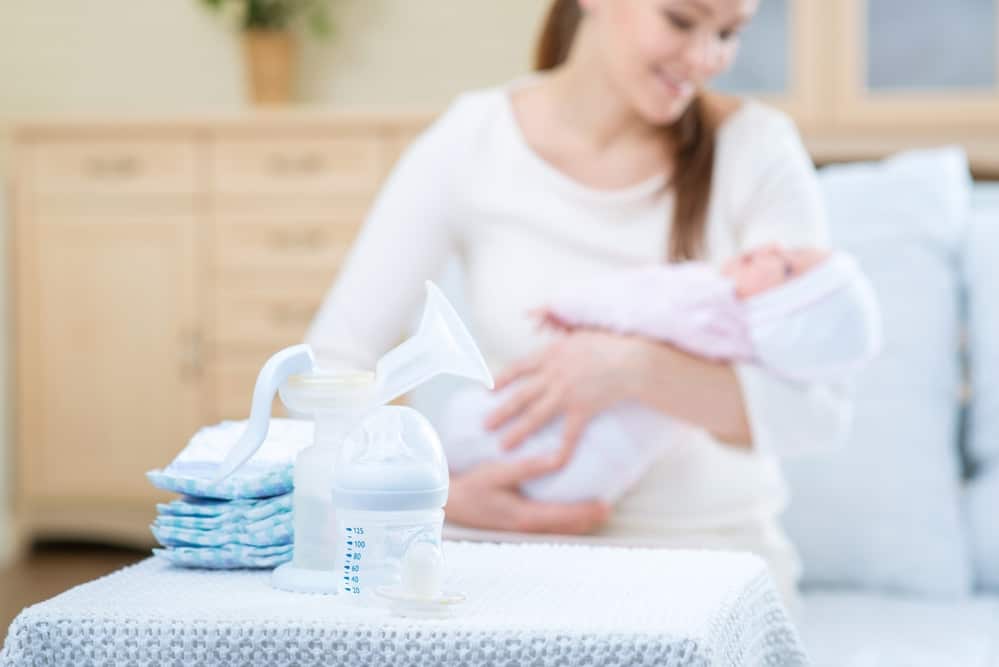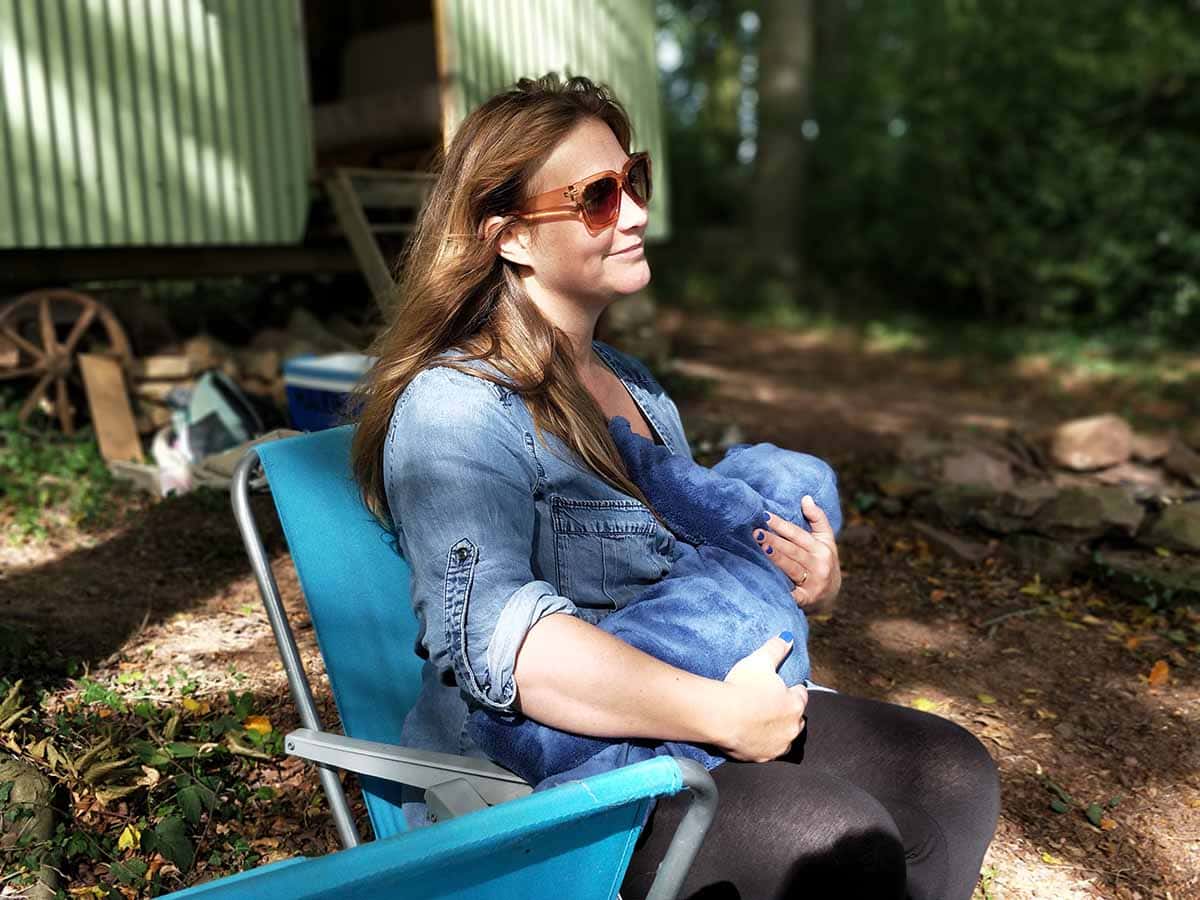What are nursing pads?
Before answering the question of how many nursing pads you need, let us explain what are these items for and who needs them. They are specially designed pads worn on the breasts to protect clothing from breast milk leaks. They help nursing mothers feel more confident during their daily activities since leaks can happen anytime and anywhere. The main causes of milk leakage are:
- The baby's strong suckling;
- Physical activity such as running, jumping, or high-impact sports;
- Infections of the breasts and nipples.
After birth, hormones make women more sensitive to oxytocin during breastfeeding. Oxytocin causes muscle contractions which in turn express breast milk. These breast milk leaks are especially common when the baby is less than 3 months old. To avoid ruining their clothes with stains, nursing mothers may need disposable or reusable nursing pads inside their bras. They usually come in folded squares or triangles which you place inside the cup of your bra to catch any leakage before it soaks through your top.
Variety
There are different types of reusable nursing pads including:
- Cotton nursing pads;
- Disposable nursing pads;
- Cloth-backed disposable nursing pads.
The best reusable pad you will need is the cloth-backed disposable nursing pad. It's a good mix between disposables and cotton, with some added advantages: It can be reused up to 5 times which makes it more economical than most other reusable pads. It looks very similar to a regular disposable pad so you don't have to worry about any special laundry instructions or washing methods. Just throw them in the trash when you're done and replace them with a new one for your next breastfeeding session.
Another advantage of these types of reusables is that they are designed with "stay dry" layers on top and bottom. This feature provides an extra layer of protection against leaks and prevents your skin from being in contact with a wet fabric. And that is exactly what breastfeeding moms need!
How can you expand your nursing pad stash?
The biggest factor that affects the amount of absorbency in a reusable pad is the fabric used. Cotton and bamboo fabrics tend to be thicker and more absorbent than other types such as flannel, fleece, or velour. On average, each nursing pad lasts about 2-3 years if it is hand washed and air dried (which also helps prevent bacterial growth).

This means that mothers might need between 60 and 120 pads for their entire breastfeeding journey! It may sound like an overwhelming number, but imagine how much money you'll save by investing in reusable pads instead of disposable ones. You'll also feel good knowing that no trees were killed just so you
How many reusable nursing pads do you need?
This is dependent upon various factors such as your lifestyle, flow output of the breasts, etc. It may take some time before you can know how many nursing pads you need to wear every day. The suggested ones are 10-15 breast pads per day for light leakage that will require changing 4-6 times a day or 8-12 pieces for moderate leakage requiring changing 3-4 times a day. For heavy leakage, it would be one disposable pad per hour being used with an additional 5-10 reusable pads for use during the day.
If you're going to use reusable nursing pads, it's a good idea to have 3-5 of them available for different occasions.
For example 2 or 3 cloth-backed disposables for home use or when you're close to the house 1 cloth-backed disposable combined with 2 cotton ones for outings such as running errands around town A few extra cotton nursing pads which you can either reuse up to 5 times by changing the cover each time or throw away after single usage. Just make sure not to wear cotton directly on your nipples because it doesn't absorb efficiently and could cause nipple irritation that is not needed.
Alternatives to nursing pads
Cotton bra pads are bigger and thicker, but also more absorbent. They're perfect for everyday use on top of nursing pads to provide some extra protection against leaks. They can be reused up to 5 times if they are washed by hand and hung to dry between uses. Breast shells are worn inside your bra around the nipple area. Their purpose is similar to nursing pads, but they only catch leaks from the nipple while still allowing airflow.
Some mothers find them useful while others don't see any benefit in using them at all because the breast shell doesn't touch the milk ducts which causes soreness and painful breastfeeding sessions when nipple rub against the fabric. Nursing tanks provide a lot of coverage without having to wear an entire shirt over your tank top. They're basically a tank top with built-in nursing pad pockets which you can take out before breastfeeding your baby. If you need them, check out the most popular offers on Internet!
What should I do if my reusable pads start leaking?
Reusable cloth pads are usually more absorbent than disposables and this is generally not a problem except in cases of heavy leaking when they get "full". Some mothers have reported that their babies pull off their breasts at the end of a feeding session because the milk flow has decreased significantly due to the absorption/drying up of milk from reusable pads. In such cases, it would be wise to carry additional disposable nursing pads to use while waiting for the reusable ones to dry up.
If you're using either disposable nursing pads or cotton bra pads, then it's a good idea to carry an extra pack with you so that you can change your pad after every feed. For this, we recommend having 2-3 packs available and switching them out at least once every few hours so that the milk doesn't get absorbed into your clothing and cause stains. If you need pieces of advice on how to get rid of milk stains, check out our article.
Some mothers prefer to double their nursing pad coverage by wearing both disposable and reusable nursing pads together during outings such as grocery shopping trips or doctor visits where they might need additional protection from leakage due to increased milk flow when stressed out.
Most women will experience some degree of leaking while breastfeeding a baby which is perfectly normal and manageable. If you're unsure whether your breasts are engorged or not, just follow the link to find out what that means and what steps you can take while breastfeeding.

Best reusable nursing pads for heavy leaking
If you suffer from heavy leaking while you're breastfeeding, then you know just how important it is to find the best reusable nursing pads for your needs. There are many options out there when it comes to reusable nursing pads, but not all of them will provide the same level of protection against heavy leaking. Some are thicker and more absorbent than others, which can make a big difference when it comes to keeping your clothing dry and comfortable throughout the day.
So, what are some of the best reusable nursing pads for heavy leaking you will definitely need? Here are just a few top options that you should consider:
- Bamboobies Nursing Pads. These soft and ultra-absorbent nursing pads are made from natural bamboo rayon fibers, so they're gentle on your skin and they'll keep you feeling dry and comfortable all day long.
- Lansinoh StayDry Disposable Nursing Pads. These pads are designed to provide leak-proof protection, thanks to their special quilted design that helps to absorb moisture quickly.
- Medela Contact Nipple Shields. If you're struggling with the sore or cracked nipple, then these nipple shields can help to protect them while you're breastfeeding. They can also help to reduce leaking by providing a barrier between your skin and your clothing.
- Earth Mama Angel Baby organic cotton reusable nursing pads. These eco-friendly nursing pads are made from 100% certified organic cotton, so they're gentle on your skin and they won't cause any irritation.
- Soothies Gel Pads. These gel pads can be used to help soothe sore or cracked nipples, and they can also help to reduce leaking by providing a barrier between your skin and your clothing.
If you're looking for the best reusable nursing pads for heavy leaking, then these are just a few of the top options that you should consider. Choose the ones that will work best for you and your needs, and you'll be able to keep your clothing dry and comfortable all day long.
Breastfeeding problems which affect leaks: Engorgement
Engorgement is caused by an over-filling of milk ducts due to unrestricted milk flow in early breastfeeding stages (lack of sufficient breast stimulation) or blocked/inverted nipple (insufficient baby's suckling). It usually occurs between the second and fifth day after birth when your body starts producing colostrum but might continue for up to 2 weeks. Some mothers get it right away because their colostrum supply isn't enough to satisfy their baby's demands or they don't produce enough milk in general right after birth.
Engorged breasts are extremely full and heavy which is why you'll need to relieve the pressure very frequently by breastfeeding or pumping. If you don't, engorgement sometimes leads to mastitis if not treated properly.
Best nursing pads you need: disposable vs reusable
Depending on brand and materials, disposable nursing pads may be made of either synthetic (plastic) or natural (cotton) fibers. They both work as an excellent moisture barrier which can't be duplicated with reusable cloth pads unless you use a nursing pad liner to protect them from leakages.
While some mothers find that reusable nursing pads increase dryness and sometimes even cause painful rubbing during breastfeeding sessions, others barely notice any difference between the two types and choose to stick to their favorite ones instead of switching between different options all the time. Reusable cotton bra inserts are very practical because they're easy to wash by hand in the sink after every use. This makes it possible for you to reuse them up to 5 times before needing replacement - just hang them to dry off.
Reusable nursing pads are also known as reusable nursing breast pads or washable breast pads because they're made of fabric that you can either machine-wash with your regular clothes or hand-wash with special detergents. If you need the latter, then make sure that your bra liner is properly cleaned after every use and dried up at least once a day to avoid any unpleasantness brought by bacteria build-up.
Another thing you need to keep in mind is that not all clothes are safe for washing in the machine with regular laundry detergents because they might contain latex which can damage certain types of fabrics over time.
Since there's no significant difference between disposable and reusable nursing bra inserts, it's usually a matter of personal preferences regarding which type you choose to get. It doesn't make any difference for mother and baby during breastfeeding sessions because both types can be worn discreetly under your clothes without being noticed or interrupting the process.
Conclusion
In general, reusable nursing pads are more suitable for mothers with a low milk supply because they can be reused multiple times before needing replacement. This will reduce the amount of money spent on disposable products each month by a significant margin which is why you should consider buying a few packs to have enough replacements while washing your favorite ones.
Reusable nursing pads are also very helpful during a mother's healing period after birth because they're much thicker than regular cotton pads and absorb leaks very well - this means that they'll never stick to open wounds or cause any pain or discomfort, unlike thin maxi pad tampons.